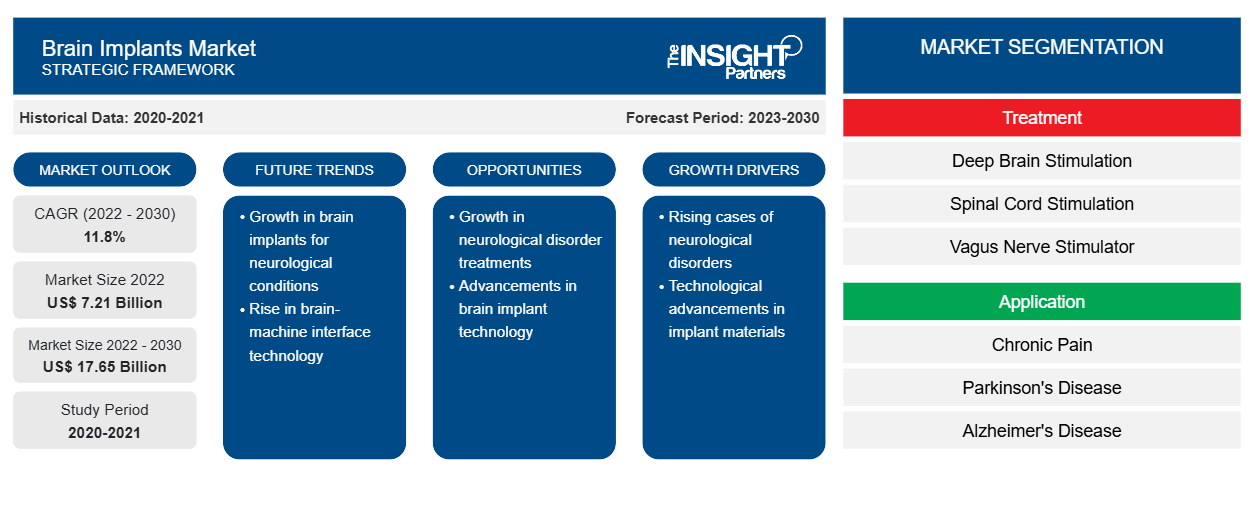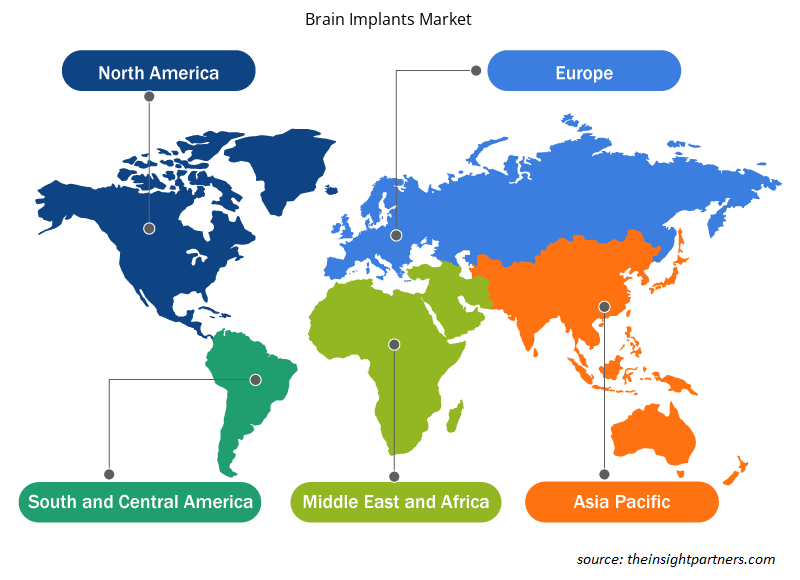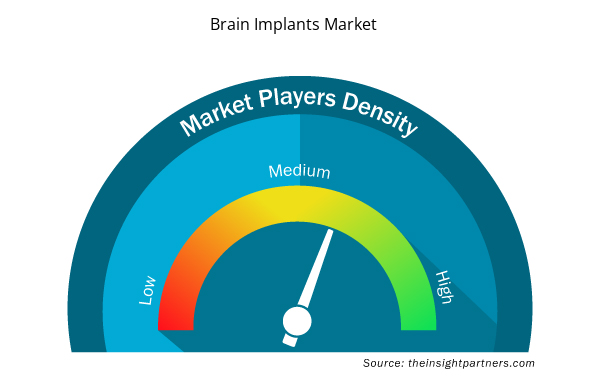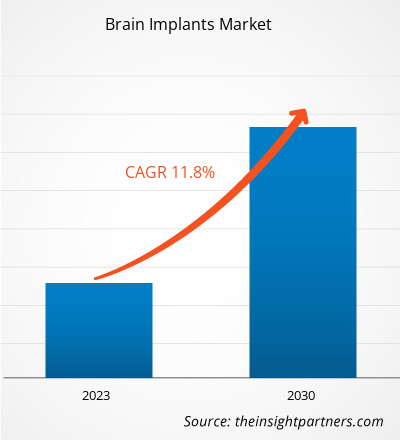[Research Report] The brain implants market size is projected to grow from US$ 7,205.80 million in 2022 to US$ 17,647.65 million by 2030; it is projected to record a CAGR of 11.8% during 2022-2030.
Market Insights and Analyst View:
Neuroscience and neurotechnology are advancing rapidly, pushing medical science to new limits as neurological diseases such as Parkinson's, Alzheimer's, and epilepsy have become more common. Brain implants offer potential therapeutic solutions by modifying neural activity and restoring normal brain function. In addition, people have become more aware of the advantages of brain implants. Growing reliance on deep brain stimulation as a safe and proven treatment for Parkinson's creates growth opportunities for the brain implants market. The market is expected to experience further growth in the coming years with the introduction and use of a larger number of neural implants to help with memory improvement, disease treatment, and prosthetic limb communication to effectively mitigate the symptoms of brain-related disorders.
Growth Drivers:
With age, elderly people are likely to develop neurological disorders that impact their mobility. Alzheimer's disease, epilepsy, Parkinson’s disease (PD), and dystonia are among the most common neurological disorders affecting the geriatric population. According to the 2020 population statistics by the US Census Bureau, the geriatric population reached 55.8 million, i.e., 16.8% of the national population; nearly 1 in 6 people in the country were aged 65 and above in 2020. Further, according to the data from the Pan American Health Organization (PAHO), Brazil has ~30 million people aged 60 and above (i.e., 13% of the country's population). The population of this age group is further expected to reach ~50 million (i.e., 24% of the total population) by 2030. According to an article published by UpToDate Inc. in August 2021, epilepsy incidence rises with age and is highest among patients aged 75 and above.
Countries such as the US and Canada have high prevalence rates of movement disorders and psychiatric disorders associated with growing geriatric populations. According to the Parkinson's Foundation, Parkinson's symptoms are common at an average age of 60. For instance, ~90,000 Americans are diagnosed with PD yearly. The organization also states that the incidence of PD increases with age; nearly 1 million people in the US are living with PD, and the number is expected to reach 1.2 million by 2030. According to an article titled “Alzheimer's disease: Can deep brain stimulation help alleviate symptoms?” published in April 2023, ~32 million people worldwide have Alzheimer’s disease. As per the Alzheimer's Disease Research Factsheet, published by BrightFocus Foundation in October 2022, ~500,000 new cases of Alzheimer's disease were diagnosed in 2022 in the US. The incidence rate of Alzheimer's increases with age. ~6.5 million Americans aged 65 and above are suffering from Alzheimer's disease, and the number is expected to reach 12.7 million by 2050. According to the World Health Organization (WHO) stats released in February 2022, approximately 50 million people suffer from epilepsy, which is one of the most common neurological diseases worldwide.
Customize This Report To Suit Your Requirement
You will get customization on any report - free of charge - including parts of this report, or country-level analysis, Excel Data pack, as well as avail great offers and discounts for start-ups & universities
Brain Implants Market: Strategic Insights

- Get Top Key Market Trends of this report.This FREE sample will include data analysis, ranging from market trends to estimates and forecasts.
Customize This Report To Suit Your Requirement
You will get customization on any report - free of charge - including parts of this report, or country-level analysis, Excel Data pack, as well as avail great offers and discounts for start-ups & universities
Brain Implants Market: Strategic Insights

- Get Top Key Market Trends of this report.This FREE sample will include data analysis, ranging from market trends to estimates and forecasts.
The increasing incidence of neurological diseases, coupled with the growing geriatric population, drives the demand for brain implants to treat and manage the disease. The deep brain stimulation (DBS) technique is used to treat epilepsy cases due to the low therapeutic response exhibited by the patient’s body to medication during seizures and reduced success rates associated with surgeries. Researchers from the University of North Carolina at Chapel Hill claim to have generated new neurons in the brain, which can be stimulated using DBS. DBS for Alzheimer's involves utilizing an implanted device similar to a heart pacemaker and two attached wires that deliver mild electrical pulses directly to the fornix area of the brain. Electrical stimulation can activate the memory circuitry in the brain to sharpen its function. Thus, neural implants such as DBS and vagus nerve stimulation are increasingly being used to treat patients with PD and other neurological conditions.
Report Segmentation and Scope:
The brain implants market is segmented on the basis of treatment, application, end user, and geography. Based on treatment, the market is segmented into deep brain stimulation, spinal cord stimulator, vagus nerve stimulator, invasive and noninvasive brain–computer interfaces, responsive neurostimulation for seizures, auditory brainstem implant, and ophthalmic aids/implant. Based on application, the market is categorized into chronic pain, Parkinson’s disease, Alzheimer’s disease, epilepsy, essential tremor, depression, dystonia, amyotrophic lateral sclerosis/stroke/spinal cord injury, and neurofibromatosis 2/total ossification of the cochlea. In terms of end user, the brain implants market is bifurcated into hospitals and specialized clinics/neurological centers. The brain implants market, based on geography, is segmented into North America (US, Canada, and Mexico), Europe (Germany, France, Italy, UK, Spain, and Rest of Europe), Asia Pacific (Australia, China, Japan, India, South Korea, and Rest of Asia Pacific), Middle East & Africa (South Africa, Saudi Arabia, UAE, and Rest of Middle East & Africa), and South & Central America (Brazil, Argentina, and Rest of South & Central America).
Segmental Analysis:
The brain implants market, by treatment, is segmented into deep brain stimulation, spinal cord stimulator, vagus nerve stimulator, invasive and noninvasive brain–computer interfaces, responsive neurostimulation for seizures, auditory brainstem implant, and ophthalmic aids/implant. The spinal cord stimulator segment held the largest share of the market in 2022. However, the invasive and noninvasive brain–computer interfaces segment is estimated to register the highest CAGR in the market during 2022–2030. Spinal cord stimulation (SCS) can help manage chronic pain when the cause cannot be entirely treated using conventional methods, or the injury cannot be repaired. This therapy offers relief and improves the daily functioning of patients suffering from chronic pain. It is indicated for the management of chronic, intractable pain of the trunk, including unilateral or bilateral pain. Furthermore, SCS helps in targeted pain relief. SCS devices are available in different varieties that can be used as an alternative to other sorts of treatments, such as opioids, to which patients can develop addiction.
According to a report published by the National Spinal Cord Injury Statistical Center in June 2021, a spinal cord injury is thought to affect nearly 296,000 persons in the US. The demand for spinal cord stimulators is likely to rise with the increasing cases of spinal cord illness. Thus, the elevated incidences of spinal illnesses and chronic lower back pain, in combination with the availability of medical reimbursements, favors the growth of the brain implants market for the SCS segment.
Based on application, the brain implants market is segmented into chronic pain, Parkinson’s disease, Alzheimer’s disease, epilepsy, essential tremor, depression, dystonia, amyotrophic lateral sclerosis/stroke/spinal cord injury, and neurofibromatosis 2/total ossification of the cochlea. The chronic pain segment held the largest market share in 2022. The Alzheimer’s disease segment is expected to register the highest CAGR during 2022–2030. Chronic pain refers to persistent or recurring pain that persists beyond the average healing time of an injury or illness, usually persisting for more than 3–6 months. It can result from various underlying conditions and can affect any part of the body. Chronic pain is a complex and multifaceted condition having a significant impact on the physical and emotional well-being, quality of life, and daily functioning of people. Managing chronic pain can be challenging as it often involves a combination of treatments—including medication, physical therapy, lifestyle changes, and psychological interventions. According to UCSF estimates, 1 in 4 persons in the US were experiencing chronic pain in 2020, and many of them were resistant to therapy. People who have pain from spinal injuries, post-stroke pain, phantom limb pain, nerve pain, and other illnesses frequently experience misery without much hope for treatment.
Brain implant technologies have been explored as an alternative approach for controlling and alleviating chronic pain in cases that cannot be controlled effectively using conventional treatments. DBS is a type of brain implant that has been studied for its potential effectiveness in chronic pain management. In March 2022, the National Institutes of Health awarded the professors of neurological surgery and staff at the USCF Weill Institute for Neurosciences a five-year grant totaling US$ 7.56 million for an advanced DBS solution as a chronic pain treatment. It's 1 of 10 grants from the NIH's Helping to End Addiction Long-Term (HEAL) Initiative that is worth more than US$ 40 million. Thus, the increasing funding for research on chronic pain propels the brain implant market for this segment.
Based on end user, the brain implants market is bifurcated into hospitals and specialized clinics/neurological centers. The hospitals segment held a larger market share in 2022 and is anticipated to grow at a higher CAGR during 2022–2030. Hospitals are complex organizations that provide healthcare services by using complicated but specialized scientific equipment. They employ teams of professionals trained to address the problems of modern medical sciences. They are all coordinated together for the common goal of restoring and maintaining good health. As specialized healthcare facilities, hospitals have key set-ups for the diagnosis, treatment, and management of various neurological conditions that may require brain implant interventions. Hospitals provide pre-and post-operative care, which includes the assessment and selection of suitable candidates for brain implants. They also prompt continuous monitoring and programming and schedule follow-up visits to ensure the proper functioning of these implants, eventually optimizing outcomes for patients undergoing implantation procedures. Hospitals serve as centers of expertise, housing multidisciplinary teams of neurologists, neurosurgeons, nurses, and other healthcare professionals who collaborate to provide specialized care for patients receiving brain implants.
Hospitals play a pivotal role in conducting research and clinical trials to advance knowledge, improve technologies, and expand the applications of brain implant devices. They serve as educational and training centers, providing opportunities for healthcare professionals to enhance their expertise in brain implantation area through specialized training programs and continuous medical education.
Regional Analysis:
Based on geography, the brain implants market is primarily divided into North America, Europe, Asia Pacific, South & Central America, and Middle East & Africa. North America captured a significant share of the global market in 2022. The US accounted for the largest share of the market in this region. The market growth in the US is attributed to the increasing prevalence of neurological diseases, rising research and development activities, and technological advancements in brain implants. According to the Parkinson's Foundation, 930,000 people in the US were suffering from PD in 2020, and the number is expected to increase to 1.2 million by 2030. Brain implants such as deep brain stimulators (DBS) have proven to be potential treatment options for PD. DBS devices have been observed to be effective in controlling tremors associated with PD. As per the Oregon Health & Science University (OSHU) Brain Institute, ~90% of patients with essential tremors in the US experienced moderate relief from symptoms after DBS.
Technological advancements and new product launches also drive the growth of the US brain implants market. In January 2020, Abbott's Infinity DBS System received US Food and Drug Administration (FDA) approval for treating PD. This system targets a specific area of the brain (the inner globus pallidus), which is associated with the symptoms of PD.
Brain Implants Market Regional Insights
Brain Implants Market Regional Insights
The regional trends and factors influencing the Brain Implants Market throughout the forecast period have been thoroughly explained by the analysts at Insight Partners. This section also discusses Brain Implants Market segments and geography across North America, Europe, Asia Pacific, Middle East and Africa, and South and Central America.

- Get the Regional Specific Data for Brain Implants Market
Brain Implants Market Report Scope
| Report Attribute | Details |
|---|---|
| Market size in 2022 | US$ 7.21 Billion |
| Market Size by 2030 | US$ 17.65 Billion |
| Global CAGR (2022 - 2030) | 11.8% |
| Historical Data | 2020-2021 |
| Forecast period | 2023-2030 |
| Segments Covered |
By Treatment
|
| Regions and Countries Covered | North America
|
| Market leaders and key company profiles |
Brain Implants Market Players Density: Understanding Its Impact on Business Dynamics
The Brain Implants Market market is growing rapidly, driven by increasing end-user demand due to factors such as evolving consumer preferences, technological advancements, and greater awareness of the product's benefits. As demand rises, businesses are expanding their offerings, innovating to meet consumer needs, and capitalizing on emerging trends, which further fuels market growth.
Market players density refers to the distribution of firms or companies operating within a particular market or industry. It indicates how many competitors (market players) are present in a given market space relative to its size or total market value.
Major Companies operating in the Brain Implants Market are:
- Boston Scientific Corp
- Medtronic Plc
- Functional Neuromodulation Ltd
- Fisher Wallace Laboratories Inc.
- Synchron Inc.
Disclaimer: The companies listed above are not ranked in any particular order.

- Get the Brain Implants Market top key players overview
Industry Developments and Future Opportunities:
Various initiatives taken by key players operating in the global brain implants market are listed below:
- In June 2023, Boston Scientific Corp received US FDA approval for the Vercise Neural Navigator 5 Software, which is used as part of the Vercise Genus Deep Brain Stimulation (DBS) Systems. It provides clinicians with simple and actionable data for efficient programming in the treatment of people living with Parkinson’s disease or essential tremor.
- In January 2021, Medtronic plc announced the enrollment in ADAPT-PD (Adaptive DBS Algorithm for Personalized Therapy in Parkinson's Disease) to evaluate the safety and efficacy of adaptive DBS in patients with Parkinson's Disease.
Competitive Landscape and Key Companies:
Boston Scientific Corporation, Medtronic, Abbott (St. Jude Medical), Renishaw Plc., NeuroPace Inc., Aleva Neurotherapeutics, Functional Neuromodulation Inc., Fisher Wallace, NeuroSpine, Cortec Neuro, Neuro Sky, Neuralink, Synchron, Blackrock Neurotech, BrainGate, Wisper AI, Onward Medical, and Paradromics are among the prominent players in the brain implants market. These companies focus on introducing new high-tech products, advancements in existing products, and geographic expansions to meet the growing consumer demand worldwide.
- Historical Analysis (2 Years), Base Year, Forecast (7 Years) with CAGR
- PEST and SWOT Analysis
- Market Size Value / Volume - Global, Regional, Country
- Industry and Competitive Landscape
- Excel Dataset


- Non-Emergency Medical Transportation Market
- Hair Extensions Market
- Artwork Management Software Market
- Explosion-Proof Equipment Market
- Military Rubber Tracks Market
- Playout Solutions Market
- Glycomics Market
- Airport Runway FOD Detection Systems Market
- Vaginal Specula Market
- Electronic Signature Software Market

Report Coverage
Revenue forecast, Company Analysis, Industry landscape, Growth factors, and Trends

Segment Covered
Treatment, Application, End User, and Geography

Regional Scope
North America, Europe, Asia Pacific, Middle East & Africa, South & Central America

Country Scope
This text is related
to country scope.
Frequently Asked Questions
The brain implants market was valued at US$ 7,205.80 million in 2022.
The brain implants market is expected to be valued at US$ 17,647.65 million in 2030.
Spinal cord stimulation (SCS) can help manage chronic pain when the cause cannot be entirely treated using conventional methods or the injury cannot be repaired. This therapy offers relief and improves the daily functioning of patients suffering from chronic pain; it uses a mild electrical current to stimulate specific nerve fibers in the spinal cord. It is indicated for the management of chronic, intractable pain of the trunk, including unilateral or bilateral pain. Furthermore, SCS helps in targeted pain relief. The method can improve the overall quality of life and sleep, and reduce the need for pain medicines. SCS devices are available in different varieties that can be used as an alternative to other sorts of treatments such as opioids, to which patients can develop addiction.
Neuroscience and neurotechnology are advancing rapidly, pushing medical science to new limits, driving the growth of the market, as neurological diseases like Parkinson's, Alzheimer's, and epilepsy become more common. Brain implants offer potential therapeutic solutions by modifying neural activity and restoring normal brain function. In addition, people have become more aware of the advantages of brain implants, and positive research outcomes are favoring brain implants market growth. Growing reliance on deep brain stimulation as a safe and proven treatment for Parkinson's creates growth opportunities for the brain implants market. The industry is expected to experience further growth in the coming years as more and more neural implants are being used to help with memory, disease treatment, and prosthetic limb communication to effectively reduce the symptoms of brain-related disorders.
The brain implants market has major market players, including Boston Scientific Corp, Medtronic Plc, Functional Neuromodulation Ltd, Fisher Wallace Laboratories Inc., Synchron Inc., Blackrock Microsystems Inc, Renishaw Plc., Abbott Laboratories, Neurospine LLC, CorTec GmbH, BrainGate, Aleva Neurotherapeutics SA, NeuroSky Inc, Neuralink Corp, NeuroPace Inc., ONWARD Medical NV, and Paradromics Inc.
Key factors driving the market growth are surging prevalence of neurological disorders with increasing geriatric population and rising number of spinal cords injuries. However, high cost associated with brain implant devices and procedures hinders the market growth.
Trends and growth analysis reports related to Life Sciences : READ MORE..
The List of Companies - Brain Implants Market
- Boston Scientific Corp
- Medtronic Plc
- Functional Neuromodulation Ltd
- Fisher Wallace Laboratories Inc.
- Synchron Inc.
- Blackrock Microsystems Inc
- Renishaw Plc.
- Abbott Laboratories
- Neurospine LLC
- CorTec GmbH

 Get Free Sample For
Get Free Sample For